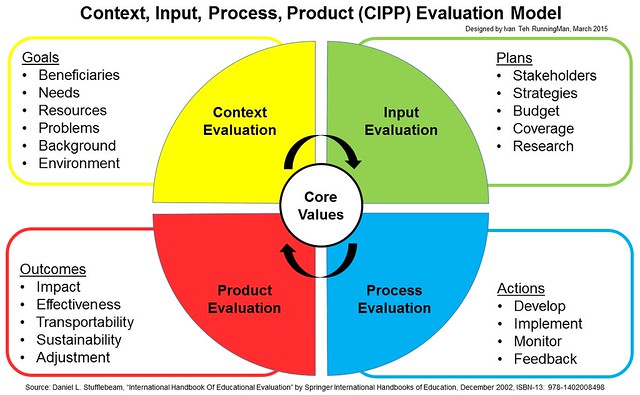CIPP Evaluation Model
Written & Researched by: Ivan Teh RunningMan
The CIPP Evaluation Model was developed by Daniel L. Stufflebeam in 1966, and further updated throughout the years, with the latest update in 2002. The CIPP Evaluation Model is a comprehensive framework for guiding evaluations of programmes, projects, personnel, products, institutions, and systems. It is a popular alternative to the Kirkpatrick / Kirkpatrick's Learning Evaluation Model, and is widely used around the world, especially by educational institutions.
CIPP stands for Context, Input, Process, Product, and these 4 main aspects comprise the CIPP Evaluation Model. The intention of this model is not to prove, but rather, to improve upon the programme itself. The CIPP Evaluation Model may be applied to educational / training programmes, to best determine the merit and worth of the training programme, as well as to determine how to improve upon it.
 |
So how is the CIPP Evaluation Model applied? Being an academic model, the CIPP Evaluation Model has at its heart, the company / institution core values, which should be kept in mind throughout. The CIPP Evaluation Model begins with Context Evaluation, which establishes the goals of the programme. At this stage, the beneficiaries and their needs are also identified, along with potential resources available on hand, and potential problems that will need to be overcome. At this stage, the background of the programme will need to be evaluated, and any social / economic / political / geographical / cultural factors within the immediate environment are to be accounted for.
At the next stage of the CIPP Evaluation Model, Input Evaluation encompasses the programme plans / planning. Stakeholders will need to be engaged, and suitable strategies of programme execution identified. Competing or conflicting strategies may also be identified. A budget will need to be allocated and suitably portioned off. To ensure sufficient coverage of the training programme, research may also have to be carried out.
With the Process Evaluation stage of the CIPP Evaluation Model, the actual actions are evaluated. This can be cyclic, repeated throughout the develop / development stage, or during the implementation / execution of the training programme. Controls to monitor the progress will have to be in place, as well as a system for feedback from learners and stakeholders, and vice versa.
Finally, the Product Evaluation stage of the CIPP Evaluation Model measures outcomes. The impact / reach of the training programme, and its effectiveness in fulfilling the objectives. Transportability seeks to determine if the training programme can be transferred, adapted, or used in a different setting. Sustainability is another aspect to be measured, accounting for how durable / long-lasting the benefits were. Adjustments to the training programme may also need to be performed at this stage.
In conclusion, the 4 aspects of the CIPP Evaluation Model respectively ask: What needs to be done (Context)? How should it be done (Input)? Is it being done (Process)? Did it succeed (Product)? The CIPP Evaluation Model provides for both a big picture overview, as well as the component overview, to better evaluate, account for, and improve upon, training programmes.
Source Attributions:
Daniel L. Stufflebeam, "CIPP Evaluation Model (Context, Input, Process, Product)" in the International Handbook Of Educational Evaluation, published by Springer International Handbooks of Education, December 2002. ISBN-13: 978-1402008498
Daniel L. Stufflebeam, "CIPP Evaluation Model Checklist" in the National Youth Leadership Council (NYLC) Resource Centre, published June 2002. Retrieved from http://www.nylc.org/sites/nylc.org/files/files/250CIPP.pdf
Amber Danielle Mazur and Christine Miller, "The CIPP Evaluation Model: A Summary" in AmberMazur Blog: A Journey Through The Evolution Of Educational Technologies, published June 2013. Retrieved from https://ambermazur.wordpress.com/2013/06/10/the-cipp-evaluation-model-a-summary/
Guili Zhang, Nancy Zeller, Robin Griffith, Debbie Metcalf, Jennifer Williams, Christine Shea, and Katherine Misulis, of East Carolina University, "Using The Context, Input, Process, And Product Evaluation Model (CIPP) As A Comprehensive Framework To Guide The Planning, Implementation, And Assessment Of Service-Learning Programs" in the Journal of Higher Education Outreach and Engagement, Volume 15, Number 4, Page 57, published by the University of Georgia, 4th Quarter 2011. Retrieved from http://files.eric.ed.gov/fulltext/EJ957107.pdf


CONVERSATION